Erected by the Historic Chattahoochee Commission and the
Auburn Heritage Association, 1994.
Erected by the Historic Chattahoochee Commission and the
Auburn Heritage Association, 1994.

Marker Dedication or Erection Date:
March 5, 1995
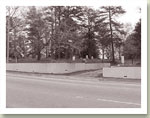 SIDE
1: BAPTIST HILL
SIDE
1: BAPTIST HILL
Auburn’s first separate black community cemetery offers
a rich source of the city’s black heritage. Much of
the history is oral but it is known that a white man gave
most of the land in the early 1870’s. The four acre
cemetery contains over 500 marked graves and many others
are unmarked. The oldest grave is dated 1879. Those interred
here are a cross section of the city’s blacks. Many
were born slaves but later succeeded in teaching or business.
The cemetery is still in use and is maintained by the City
of Auburn but its ownership is unknown. Documentation of
the site was done by the auburn Heritage Association in
1990.
Erected by the Historic Chattahoochee Commission
and the Auburn Heritage Association, 1994.
SIDE 2: BAPTIST HILL
Though located at the base of a slope, the cemetery derives
its name from Ebenezer Baptist Church on a hill to the west.
Ebenezer, established in 1865, was the first black churched
formed in Auburn after the Civil War. The church building
was erected before 1870 on land donated by Lonnie Payne,
a white man. The church was so prominent in the area that
it gave the name “Baptist Hill” to the vicinity.
Its members were the first buried in the cemetery although
members of other black churches are now interred here. Ebenezer
was placed on the National Register of Historic Places in
1978. The cemetery was added to the Alabama Register in
1994.
Erected by the Historic Chattahoochee Commission
and the Auburn Heritage Association, 1994.

City
Hall
Location: Located at 144
Tichenor Avenue, Auburn, Alabama
Marker Dedication or Erection Date:
September 17, 2002
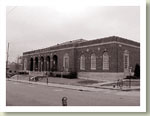 SIDE
1: CITY HALL
SIDE
1: CITY HALL
In 1846, Auburn’s Founder, Judge John J. Harper deeded
the property on this corner to Simeon Perry, as town agent
for two of the earliest public schools in Auburn. A member
of the settlement party, Perry laid out the original boundaries
of the City of Auburn. In 1931, the City of Auburn donated
this land for a larger post office. Congress gave $90,000
for its construction and the building was completed in 1933,
while Levi Knapp was Postmaster. First class status was
attained here in 1940 under Postmaster Homer Wright, and
it served as the post office until 1991. It was at least
the seventh location for town postal service.
Erected by the Historic Chattahoochee Commission,
the City of Auburn and the Auburn Heritage Association,
2002
SIDE 2: CITY HALL
The City of Auburn bought the building in 1992 for $375,000.
In 1999, the City Council voted to renovate it as City Hall.
It was dedicated in 2001. The building has a “Starved-Classical,”
symmetrical style, with pointed pediments, typical of Federal
Depression architecture. These elements have been preserved
through several additions and renovations. Postmasters who
served Auburn on this site: Levi A. Knapp; Homer Wright;
Mrs. Katherine Wright; Jay G. Hitchcock; Harold Nall; Charles
M. Dawson; Bill Kitchen; J. Dan McLaughlin. The building
was listed on the National Register of Historic Places by
the U.S. Department of the Interior in 1983.
Erected by the Historic Chattahoochee Commission,
the City of Auburn and the Auburn Heritage Association,
2002

Dillard-Lawson House
Marker Dedication or Erection Date:
2000
Marker Text:
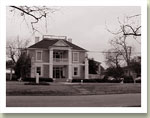 Built
by Auburn merchant A. L. Dillard in 1894, the home was once
part of the old Scott Plantation. It was one of the first
homes in Auburn to have an indoor bath and electricity.
An unusual feature of the house is the gray stone, for which
Dillard invented a secret formula to make it moisture proof.
Mrs. Dillard and her daughter were the first registered
women voters in Lee County. In 1925, Sigma Pi Fraternity
was chartered here. The James L. Lawson family owned the
house from 1939-1984. It was home to Mabel Yearby, the first
woman defense lawyer in Alabama. In 1984 the house was sold
to business interests.
Built
by Auburn merchant A. L. Dillard in 1894, the home was once
part of the old Scott Plantation. It was one of the first
homes in Auburn to have an indoor bath and electricity.
An unusual feature of the house is the gray stone, for which
Dillard invented a secret formula to make it moisture proof.
Mrs. Dillard and her daughter were the first registered
women voters in Lee County. In 1925, Sigma Pi Fraternity
was chartered here. The James L. Lawson family owned the
house from 1939-1984. It was home to Mabel Yearby, the first
woman defense lawyer in Alabama. In 1984 the house was sold
to business interests.
Erected by the Auburn Heritage Association
and the Historic Chattahoochee Commission, 2000.

Ebenezer
Baptist Church / Baptist Hill / East Thach Avenue
Location: Located at the
Church on East Thach Avenue, Auburn, Alabama.
Marker Dedication or Erection Date:
December 10, 1978
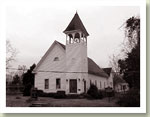 SIDE
1: EBENEZER BAPTIST CHURCH / BAPTIST HILL / EAST THACH AVENUE
SIDE
1: EBENEZER BAPTIST CHURCH / BAPTIST HILL / EAST THACH AVENUE
This simple frame structure was built by newly freed black
men and women before 1870. The property on which the building
stands was given to a member of the Ebenezer congregation
in 1865, the year the War Between the States ended, by a
white landowner, Lonnie Payne. The church is built of hand
hewn logs, felled on the Frazer plantation, northeast of
Auburn, and were hauled by mule to this site. Members of
the congregation constructed the building. The Church and
its early leaders figured prominently in Alabama’s
black Baptist history. The church congregation held its
services here until 1969.
SIDE 2: EBENEZER BAPTIST CHURCH /
BAPTIST HILL / EAST THACH AVENUE
Pastors serving church at this site: Reverend Tom Glynn
Reverend Ishman Pollard Reverend I. T. Simpson Reverend
C. J. Davis Reverend H. E. Jones Reverend Saunders Reverend
O.D. Slaughter Reverend J. M. Alexander Reverend G. R. Young,
Jr.
Erected by the Historic Chattahoochee Commission,
1978

General
James Henry Lane House/Woman’s Club of Auburn
Location: Located at the
corner of Thach & College Street, Auburn, Alabama.
Marker Dedication or Erection Date:
October 8, 1992
Marker Text:
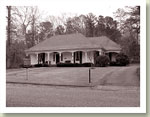 The
Lane House, built in 1853 at the corner of Thach and College
Street, was home to several Auburn University notables.
E. T. Glenn, Treasurer, leased it in 1873. General James
H. Lane, Aide to General Stonewall Jackson and Head of Engineering,
purchased the house in 1884. Daughter Mary married Dean
George Petrie, author of the Auburn Creed. Daughter Kate
Meade Lane was the last resident. Mollie Hollifield Jones
purchased the house in 1960 for the Woman’s Club.
The house was moved to its present location in 1962. It
was placed on the Alabama Register of Landmarks and Heritage
in 1991.
The
Lane House, built in 1853 at the corner of Thach and College
Street, was home to several Auburn University notables.
E. T. Glenn, Treasurer, leased it in 1873. General James
H. Lane, Aide to General Stonewall Jackson and Head of Engineering,
purchased the house in 1884. Daughter Mary married Dean
George Petrie, author of the Auburn Creed. Daughter Kate
Meade Lane was the last resident. Mollie Hollifield Jones
purchased the house in 1960 for the Woman’s Club.
The house was moved to its present location in 1962. It
was placed on the Alabama Register of Landmarks and Heritage
in 1991.
Erected by the Historic Chattahoochee Commission
and the Women’s Club of Auburn, 1992.

Lee
County Courthouse
Location: Located on Lee
County Courthouse lawn, Opelika, Alabama.
Marker Dedication or Erection Date:
July 19, 1978
SIDE 1: LEE COUNTY COURTHOUSE
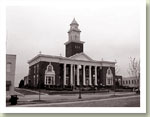 Lee
County was created from portions of Russell, Macon, Chambers
and Tallapoosa by act of the Alabama legislature, approved
December 5, 1866. The county’s first election was
held January 21, 1867. An early courthouse stood across
the street from the present structure. In 1896, when W.
C. Robinson was Probate Judge, erection of today’s
courthouse got underway: low bid, $23, 000; architect’s
fee, $1,000; total bond issue, including jail, $35,000.
Last bonds paid off in late 1930’s. Placed on the
National Register of Historic Places July 23, 1973.
Lee
County was created from portions of Russell, Macon, Chambers
and Tallapoosa by act of the Alabama legislature, approved
December 5, 1866. The county’s first election was
held January 21, 1867. An early courthouse stood across
the street from the present structure. In 1896, when W.
C. Robinson was Probate Judge, erection of today’s
courthouse got underway: low bid, $23, 000; architect’s
fee, $1,000; total bond issue, including jail, $35,000.
Last bonds paid off in late 1930’s. Placed on the
National Register of Historic Places July 23, 1973.
Erected by the Historic Chattahoochee Commission,
1978.
SIDE 2: LEE COUNTY PROBATE JUDGES
David Read, January 21, 1867- August 10, 1872 Wilson Williams,
August 1872 – 1880 James K. Edwards, 1881- October
20, 1883 Thomas L. Frazer, November 2, 1883 - 1886 William
Carlisle Robinson, 1887 – 1898 Frank Monroe Renfro,
1899 – 1904 John B. Lyons, Late 1904 – May 24,
1915 Griffin P. Butler, June 1, 1915 – November 28,
1932 Lum Duke, late 1932 – January 1935 John T. Frazer,
January 15, 1935 – January 25, 1949 James Lewis Killian,
1949- 1950 Ira H. Weissinger, Sr., November 11, 1950 –
January 17, 1977 I. H. (Hal) Smith, January 18, 1977 –
Erected by the Historic Chattahoochee Commission,
1978.

Noble
Hall
Location: Located at 1433
Lee Road 97, 3 miles north of Auburn, Alabama.
Marker Dedication or Erection Date:
1988
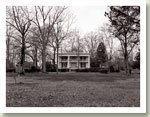 SIDE
1: NOBLE HALL
SIDE
1: NOBLE HALL
Side 1 The Greek Revival rock and mortar house was built
by Addison Frazer (1809-1873) between 1852 and 1854 and
served as the center for a 2,000 acre cotton plantation.
Frazer owned 100 slaves and was on the Board of Trustees
of Auburn Masonic Female College and East Alabama Male College.
The contractor from Kentucky used slave labor to build the
eight rooms with 12 foot high ceilings and 18 inch exterior
walls, two cantilever balconies and eight Doric columns.
In the rear are the original separate kitchen, carriage-smokehouse
and overseer’s house. The Frazer family owned the
house until 1922.
Erected by the Historic Chattahoochee Commission
and the Lee County Historical Society, 1988.
SIDE 2: NOBLE HALL
In 1932, J. V. Brown, Head of Buildings and Grounds at Alabama
Polytechnic Institute, now Auburn University, bought the
house and began restoration. In 1941, he sold it and 251
acres to Dr. Luther Noble Duncan (1875-1947), who served
as president of A.P.I. (1935-1947). In 1943 his daughter,
Elizabeth Pearson (Mrs. Allen M.), and family occupied the
house and continued restoration. Mrs. Pearson inherited
the house in 1951, collected its furnishings and named it
Nobel Hall. In 1972 it was the first building in Lee County
to be listed on the National Register of Historic Places.
Erected by the Historic Chattahoochee Commission
and the Lee County Historical Society, 1988.

Pine
Hill Cemetery
Marker Dedication or Erection Date:
November 2, 1997
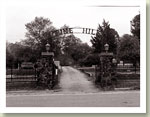 SIDE
1: PINE HILL CEMETERY
SIDE
1: PINE HILL CEMETERY
Pine Hill was established in 1837 and is the oldest cemetery
in Auburn. Judge John J. Harper, Auburn’s founder,
donated almost six acres to the new town to be used as a
community burying ground for white settlers and their slaves.
The original part of the cemetery lies to the north and
contains the oldest marked grave – 1838. Early cemetery
records are non-existent as the fist survey was conducted
in the 1950’s when over 1,100 marked graves were cataloged.
Of this number, only one black grave is identified. A cross
section of Auburn Citizens are buried here including University
presidents and slaves.
Erected by the Auburn Heritage Association
and the Historic Chattahoochee Commission, 1995.
SIDE 2: PINE HILL CEMETERY
In the 1870’s a separate cemetery, Baptist Hill, opened
to the southeast. For decades Pine Hill served as the primary
burying ground for whites in the area. The city’s
Confederate marker rises at the rear of the cemetery over
the common graves of 98 Texas soldiers who died in a temporary
hospital housed in a college building known as “The
Main.” Pine Hill suffered from vandalism and neglect
until 1995 when the Auburn Heritage Association launched
a restoration of the cemetery. It was placed on the Alabama
Register in 1978 and is owned and maintained by the City
of Auburn.
Erected by the Auburn Heritage Association
and Historic Chattahoochee Commission, 1995.

Robert
Wilton Burton
Location: Located in front
of Burton House Apartments on East Magnolia, in Auburn,
Alabama.
Marker Dedication or Erection Date:
1999
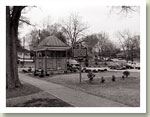 SIDE
1: ROBERT WILTON BURTON 1848-1917
SIDE
1: ROBERT WILTON BURTON 1848-1917
Near this site once stood “Four-Story Cottage,”
the home of Robert Wilton Burton. A one-story house with
wide porch and bay window, Burton built it in 1885 with
proceeds from the sale of four stories to children’s
magazines. Born in Camden County, Georgia, Burton grew up
in Lafayette, Alabama, where he began writing stories for
the newspaper, on various subjects. In the early 1870’s,
with his brother, he opened a bookstore in Opelika, Alabama.
In 1878, at the request of the Agricultural and Mechanical
College of Alabama, Burton opened the first bookstore in
Auburn. It was soon known as the “Coffee House of
the College City.”
Erected by the Auburn Heritage Association
and Historic Chattahoochee Commission, 1999.
SIDE 2: ROBERT WILTON BURTON
Burton wrote numerous local color stories for national magazines
and newspapers. Many of his best tales, in Negro dialect,
feature “Marengo Jake” Mitchell, a former slave
in Auburn known for his tall tales. In 1991, these stories
were published as “De Remnant Truth.” An active
Presbyterian, Burton also served as Secretary of the Town
Board of Education, County School Superintendent, Clerk
of the Town Council, and Secretary to the College Board
of Trustees. His bookstore was sold in 1968; his home dismantled
in 1993.
Erected by the Auburn Heritage Association
and Historic Chattahoochee Commission, 1999.

Scott-Yarbrough
House
Location: Located at 101 Debardeleben Street,
Auburn, Alabama
Marker Dedication or Erection Date:
December 10, 1978
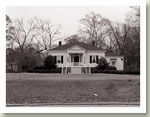 SIDE
1: SCOTT-YARBROUGH HOUSE
SIDE
1: SCOTT-YARBROUGH HOUSE
Home of Nathaniel J. Scott Family 1847-1871. Colonel Nathaniel
J. Scott, from Harris County Georgia, and brother-in-law
of John J. Harper (1807-1863), founder of Auburn, Alabama,
built this house, which he called “Pebble Hill,”
on 100 acres at this site in 1847. With its pyramidal roof
and symmetrical lines, the frame house reflects the Greek
Revival architecture popular at the time. Colonel Scott
was one of four commissioners appointed to lay out and manage
the town of Auburn. He organized the East Alabama Masonic
Female College in 1847. In 1856, he led in the establishment
of East Alabama Male College, now Auburn University. Colonel
Scott was Auburn’s first State Legislator.
SIDE 2: SCOTT-YARBROUGH HOUSE
Owned by Dr. Cecil Yarbrough Family 1912-1974. “Pebble
Hill” was purchased in 1912 by Dr. Cecil S. Yarbrough
(1878 -1940) for his family home. Dr. Yarbrough served in
the Alabama State Legislature in the 1920’s. He served
three times as Mayor of Auburn, in 1918, in 1921-22 and
from 1936-44. He was college physician during World War
II. The Auburn Heritage Association purchased the House
in 1974. The raised cottage rests on a brick foundation.
The joists and rafters are pegged. The floors are hand hewn
heart pine. Owners between 1871-1912: Ray, Hollifield, Riley,
Hodges.
Erected by the Historic Chattahoochee Commission,
1978.

The
Baughman-Honour-Stiles House
Marker Dedication or Erection Date:
2001
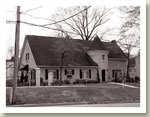 Marker
Text:
Marker
Text:
Designed by William Dryden Baughman and built by Fred Burk
in 1929, the house was not finished due to the Great Depression.
Because of its two-story turret and French Norman Style,
it became known as “The Castle.” In 1949, the
home was sold to architect Wilfred M. Honour. In 1996, Warren
and Mary Ann Stiles purchased it and restored the original
heart pine wood floors, gothic archways, wrought iron fixtures
and French millwork. They completed the unfinished tower
room and the entire second story.
Erected by the Historic Chattahoochee Commission
and the Auburn Heritage Association, 2001.

Wittle
Dormitory
Marker Dedication or Erection Date:
1999
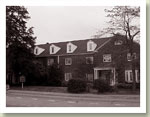 Marker
Text:
Marker
Text:
Wittel Dormitory has long been admired as one of Auburn’s
most significant examples of classic nineteenth-century
design. Built in the early 1900’s by Samuel S. Wittel
to house professional women, it also served as a home for
three generations of the Wittel family. After World War
II enrollment at the Polytechnic Institute, which is now
Auburn University, rose dramatically and Wittel became Auburn’s
first dormitory for college women. The original structure
features copper roof details, wood floors throughout, silver
plate applied to the front entrance ceilings and Auburn’s
first elevator.
Erected by the Historic Chattahoochee Commission
and the Auburn Heritage Association, 1999.

Wright's
Mill
Location: Located at the
entrance of Chewacla State Park, four miles south of Auburn,
Alabama.
Marker Dedication or Erection Date:
July 18, 1979
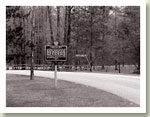 SIDE
1: WRIGHT’S MILL
SIDE
1: WRIGHT’S MILL
A popular recreation area for more than 100 years. Original
dam located a short distance below Chewacla Lake Dam. Mill
located on the west bank and ground both corn and wheat.
Earlier mill owners from 1840’s were Echols, Hiram
Reed, Charles Nelms, and John F. Lewis. W.W. Wright (1825
– 1905) owned the mill from about 1873 into early
1900’s when it was abandoned. Most of these years
his miller was Joe Broome. Just before Town Creek enters
the Chewacla is the Gin-Saw Hole. A water powered gin and
sawmill were located here in the 1840’s. For many
years it was a very popular swimming hole.
Erected by the Historic Chattahoochee Commission
and the Auburn Heritage Association, 1979.
SIDE 2: WRIGHT’S MILL
In early 1890’s a club house was built on the hill
between Wright’s Mill and the Gin-Saw Hole. This was
a favorite area for Auburnites before Town Creek was contaminated
by Auburn Sewage. A bicycle club was formed in Auburn circa
1900. George Petrie and B. B. Ross were prominent members.
A bicycle path was constructed from Auburn to Wright’s
Mill. It began where Gay Street formerly terminated at Samford
Avenue following the east bank of Town Creek much of the
way. Chewacla State Park was opened in 1939 and this park
included the Wright’s Mill area. Erected by the Historic
Chattahoochee Commission and the Auburn Heritage Association,
1979.



